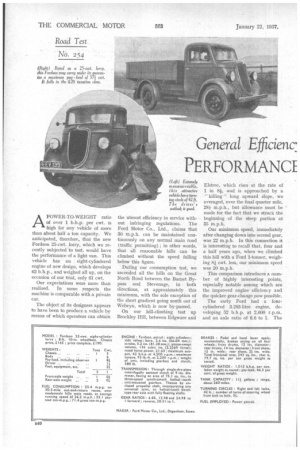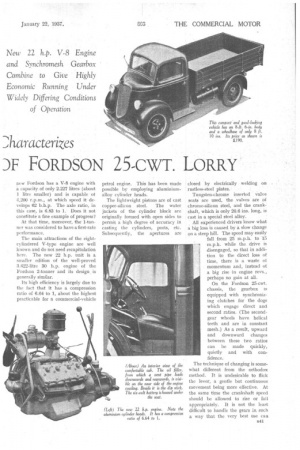General Efficienc: 13haracterizes
Page 50

Page 51

Page 52

If you've noticed an error in this article please click here to report it so we can fix it.
PERFORMANCE
DF FORDSCYN
25-CWT. LORRY
APOWER-TO-WEIGHT ratio of over 1 b.h.p. per cwt. is high for any vehicle of more than about half a ton capacity. We anticipated, therefore, that the new Fordson 25-cwt. lorry, which we recently subjected to test, would have the performance of a light van. This vehicle has an eight-cylindered engine of new design, which develops 62 b.h.p., and weighed all up, on the occasion of our trial, only 61 cwt.
Our expectations were more than realized. In some respects the machine is comparable with a private car. the utmost efficiency in service without infringing regulations. The Ford Motor Co., Ltd., claims that 30 m.p.h. can be maintained continuously on any normal main road (traffic permitting) ; in other words, that all reasonable hills can be climbed without the speed falling below this figure.
During our consumption test, we ascended all the hills on the Great North Road between the Barnet Bypass and Stevenage, in • both directions, at approximately this minimum, with the sole exception of the short gradient going south out of Welwyn, which is now by-passed.
On our hill-climbing test up Brockley Hill, between Edgware and Elstree, which rises at the rate of 1 in 8, and is approached by a " killing" long upward slope, we averaged, over the final quarter mile, 28+ m.p.h., but allowance must be made for the fact that we struck the beginning of the steep portion at 35 m.p.h.
Our minimum speed, immediately after changing down into second gear, was 22 m.p.h. In this connection it is interesting to recall that, four and a half years ago, when we climbed this hill with a Ford 1-tonner, weighing 81 cwt. less, our minimum speed was 20 m.p.h.
This comparison introduces a number of highly interesting points, especially notable among which are the improved engine efficiency and the quicker gear-change now possible.
The early Ford had a fourcylinclered 3.283-litre engine, developing 52 b.h.p. at 2,600 r.p.rn. and an axle ratio of 6.6 to 1. The
new Fordson has a V-8 engine with a capacity of only 2.227 litres (about litre smaller) and is capable of 4,200 r.p.m., at which speed it develops 62 b.h.p. The axle ratio, in this case, is 6.83 to 1. Does it not constitute a fine example of progress? At that time, moreover, the 1-tonner was considered to have a first-rate performance.
The main attractions of the eightcylindered V-type engine are well known and do not need recapitulation here. The new 22 h.p. unit is a smaller edition of the well-proved 3.622-litre SO h.p. engine of the Fordson 2-tonner and its design is generally similar.
its high efficiency is largely due to the fact that it has a compression ratio of 6.64 to 1, about the highest practicable for a commercial-vehicle petrol engine. This has been made possible by employing aluminium alloy cylinder heads.
The lightweight pistons are of cast copper-silicon steel. The water jackets of the cylinder block are originally formed with open sides to permit a high degree of accuracy in casting the cylinders, ports, etc. Subsequently, the apertures are closed by electrically welding on rustless-steel plates.
Tungsten-chrome inserted " valve seats are used, the .valves are of chrome-silicon steel, and the crankshaft, which is only 20.6 ins, long, is cast in a special steel alloy.
All experienced drivers know what
a big loss.is caused by a slow change on a steep hill. The speed may easily
fall from 25 m.p.h. to 15 m.p.h. while the drive is disengaged, so that in addition to the direct loss of time, there is a waste of momentum and, instead of a big rise in engine revs., perhaps no gain at all.
On the Fordson 25-cwt.
chassis, the gearbox is equipped with synchronizing clutches for the dogs which engage direct and second ratios. (The secondgear wheels have helical teeth and are in constant mesh.) As a result, upward and downward changes between these two ratios can be made quickly, quietly and with confidence.
The technique of changing is some what different from the orthodox method. It is undesirable to flick the lever, a gentle but continuous movement being more effective. At the same time the crankshaft speed should be allowed to rise or fall appropriately. It is not the least difficult to handle the gears in such a way that the very best use can be made of the power available.
Consistent with the good characteristics already outlined, the running of this machine is so econothical in respect of fuel consumed that there is an excuse for a degree of incredulity of the result obtained. The possibility of error, however, is small, for although a test tank—the most satisfactory means—was not used, the main-tank level Was carefully gauged, and the quantity needed for replenishment was accurately measured.
Over a distance of 30i miles, traversed at a 30 m.p.h. cruising :peed, slightly less than 104 pints of petrol were consumed. That is equivalent to 23.4 m.p.g., a figure which is well above to-day's estimated rate for the 25-cwt. class.
The route, mentioned earlier, in • chided six top-gear hills and one which necessitated the use of second gear, whilst a stop due to traffic was made at the foot of the steepest hill.
On this and several other occasions we had cause to remark upon the flexibility of the power unit. On Digswell Hill it accelerated in top gear from 20 m.p.h. to 30 m.p.h. effortlessly and rapidly.
On the level, as may be observed from the accompanying acceleration graph, 30 m.p.h. is reached, from a standing start, in 12 secs. ; this is almost car performance. Despite the steep steps between ratios, the delays caused by changing gear are brief.
As for braking, in the course of testing a large number of vehicles of all types and sizes, we have handled few that could be brought to rest from 30 m.p.h. in under 45 ft. It seems that this is the lowest figure practicable on all counts. It proved to be the stopping distance (from this .speed) of the vehicle under review.
The vigorous applica
tion. of the brakes which gave this return resulted in locking the back wheels and a long slide over the dry tarred surface. No
1342 tendency to skid was revealed by the front wheels, and there is little doubt that, if it were desirable, a still better figure could be obtained by apportioning to them more of the braking force available. The smoothness tif the brakes is noteworthy.
In studying the retardation graph, no great significance should be attached to the hand brake curve. The efficacy of this brake is merely a question of application, and the lever is normally used simply to hold the brake on, or to release it, the force being applied by the foot.
Whilst such an arrangement is
satisfactory we do not consider it ideal. There are conditions under which it is preferable, although not necessarily essential, to be able to operate the brakes, without Undue effort, entirely independently of thefoot. A vehicle so generally eXcellent and of such advanced design in other respects is worthy of a better hand brake.
For the other controls, particularly the steering, we have nothing but praise, and the centrifugally assisted clutch is a refinement of which we approve.
Our test of restarting on a gradient of 1 in 6, which often constitutes a difficulty, was accomplished As_ on other models, triangulated radius rods positively control the motion of the front and rear axles relative to the frame, and a transverse front spring is used, giving three-point suspension. This arrangement is sound in theory and satisfactory in practice. Comfort and stability on bad roads are the result.
Within the spacious and well-built cab, the power unit does not assert its presence, although so close at hand; it is commendably quiet. The outlook is unrestricted, this applying to the rear view as well, and ventilation provides no problem.
















































































































